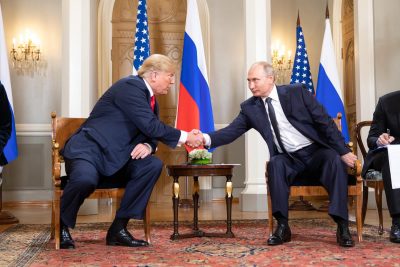Scuttling New START Treaty: Trump’s China Distraction

“If we want to preserve strategic stability using arms control as a counterpart of that, as a tool in that toolkit, then China should be in as well.” – US Defence Secretary Mark Esper, Defense News, Feb 26, 2020
For a person keen on throwing babies out with their bath water, only to then ask for their return, President Donald Trump risks doing giving that same treatment to the New START treaty. The New Strategic Arms Reduction Treaty, also known as the Treaty on Measures for the Further Reduction and Limitation of Strategic Offensive arms, a creation of the Obama administration, is due for renewal come February 2021.
Created to replace the 1991 START document, it limits long-range nuclear weapons programs for both the United States and Russia in terms of restricting the number of strategic nuclear delivery systems and the total number of warheads that can be used on those systems, buttressed by a verification regime and possible extensions for up to five years. The document is also the only significant nuclear arms control agreement left after the ditching of the Intermediate-Range Nuclear Forces Treaty.
New START has its fans in the policy fraternity. Former Chairman of the Joint Chiefs of Staff Admiral Michael Mullen, in arguing for its extension, has made the point that the treaty “contributes substantially to the US national security by providing limits, verification, predictability, and transparency about Russian strategic nuclear forces.”
Frank G. Koltz, former Undersecretary of Energy for Nuclear Security, claims it delivers “important equities” to the US military by imposing limits on Russian intercontinental ballistic missiles, submarine-launched ballistic missiles and nuclear-equipped heavy bombers at known and predictable levels. The verification regime also enables the US to achieve some degree of insight into Russian capabilities beyond traditional methods of intelligence gathering. “Taken together, these features of the treaty help reduce uncertainty regarding the future direction of Russian nuclear forces and thereby provide the US military with greater confidence in its own plans and capabilities.”
The verification regime should not be dismissed as mere theatre. It has been taken seriously enough by both parties. As of August 2019, both had exchanged something in the order of 18,500 notifications. US inspectors had conducted over 150 on-site inspections in Russia. Without it, as Admiral Mullen posits, “we would be flying blind.”
Despite such cheer, both Moscow and Washington have shown, at various stages, a desire to renegotiate the deal. Cobwebs and creaks have developed. The Russian position on this has mellowed: renewal can take place without conditions. The Trump administration, on the other hand, has dug its heels in. The document, for instance, fails to cover tactical nuclear weapons, a field in which Russia is doing rather well. (US Defence Secretary Mark Esper puts the number of such devices at 2,000.) Nor does it cover the nature of novel nuclear delivery systems, another area where Russia is accused of excelling in.
But it is the third point of contention that exercises Trump the most: China. Renegotiating New START would see Beijing left out of US ambitions to restrain another competitor, even if that competitor, in the scheme of things, is relatively small beer, with 290 nuclear warheads (both Russia and the United States boast roughly 6,000 each). The person tasked with this Herculean and, in all likelihood futile mission, is the new envoy for arms control, Marshall Billingslea.
The PRC and its conduct in this field has become something of a bizarre fixation, according to Daniel Larison. With the PRC being given rough and ready lashings of opprobrium for being the cause of COVID-19, getting the PRC to nuclear negotiations prior to February 2021 will be a tall order. To this can be added the traditional refusal by China to engage in arms limitation talks, though the President would have you think differently, suggesting last December that Chinese officials “were extremely excited about getting involved. … So some very good things can happen with respect to that.”
Specialists in the field of arms control sense that China would only come to any table of negotiation if something were to be tangibly and generally sacrificed by either Moscow and Washington. President Obama’s Undersecretary of State for Arms Control and International Security Rose Gottemoeller, at an event held in January by the Defense Writers Group, suggestedintermediate-range constraints of ground-launched missiles as a starting point, as China is “staring at the possibility of a deployment of very capable US missiles of this kind.” But the inescapable feeling in looking at the Trump playbook regarding China’s potential admission is that it is a grand distraction nurtured to conceal a desire to led New START lapse.
There is one glaring problem behind adding China to any expanded arrangement. Even if Beijing were convinced to come into it, the smaller quantity of nuclear weapons it possesses would lead to a rather odd result. Not being anywhere near either the Russian and US ceiling would be an incentive to build more weapons and systems. In doing so Beijing would still be abiding by the letter of the agreement, a grimly ironic state of affairs for an instrument designed to limit, rather than expand, strategic nuclear arsenals.
*
Note to readers: please click the share buttons above or below. Forward this article to your email lists. Crosspost on your blog site, internet forums. etc.
Dr. Binoy Kampmark was a Commonwealth Scholar at Selwyn College, Cambridge. He lectures at RMIT University, Melbourne. He is a frequent contributor to Global Research and Asia-Pacific Research. Email: [email protected]
Featured image: President Donald J. Trump and President Vladimir Putin of the Russian Federation | July 16, 2018 (Official White House Photo by Shealah Craighead)

